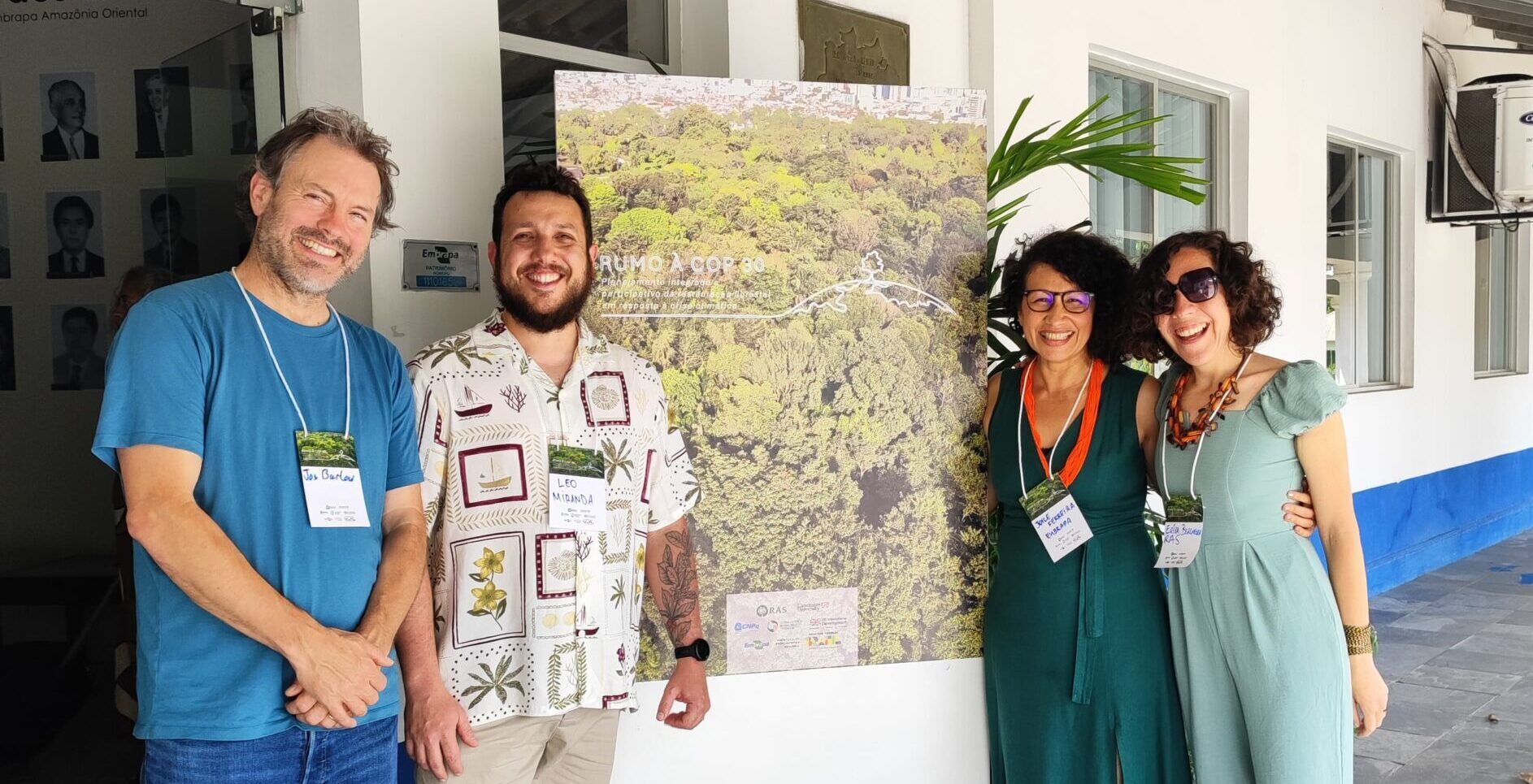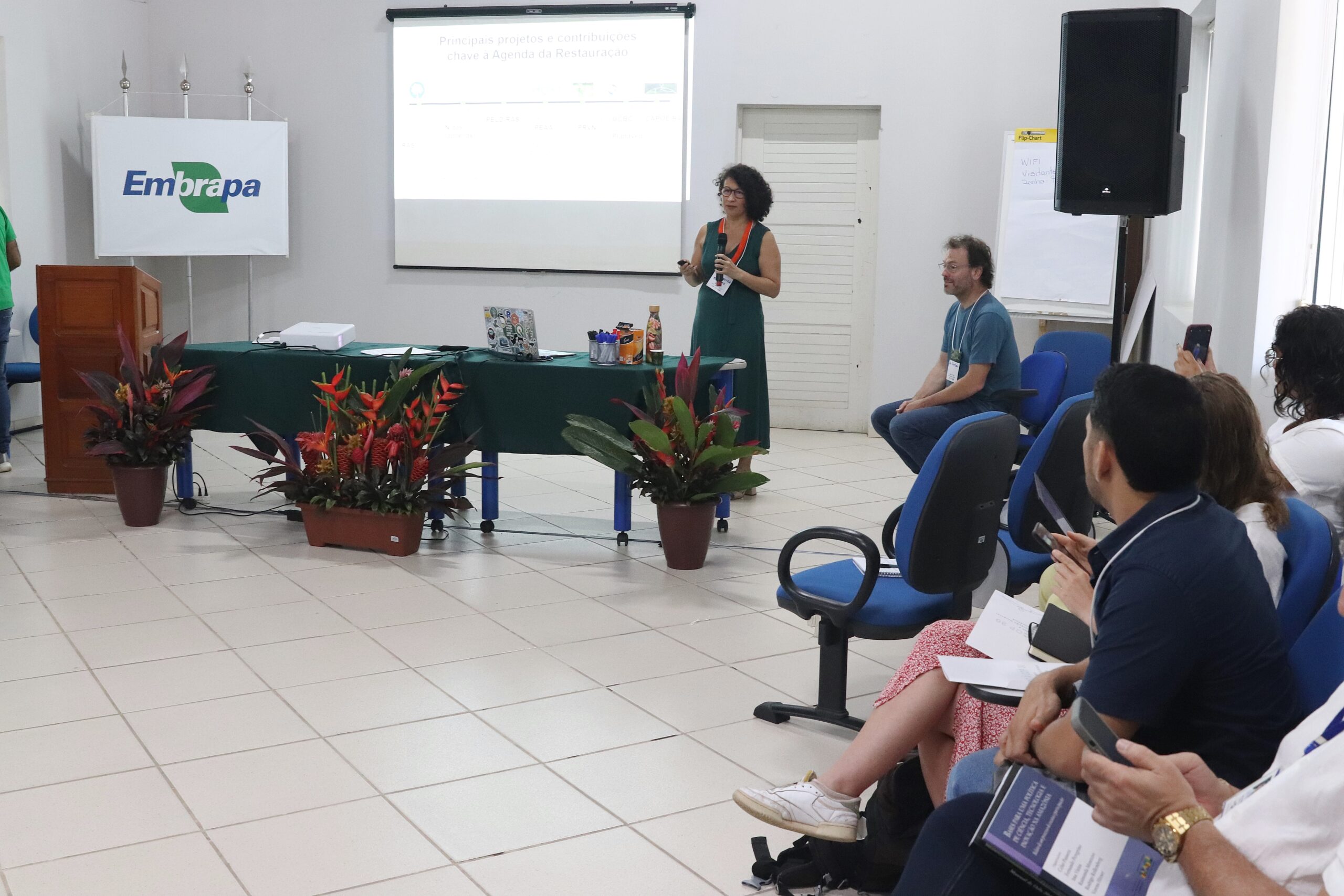Towards COP30: Belém Workshop Explores Forest Restoration in Pará
On 10 June 2025, the city of Belém hosted a key event on the future of forest restoration in the state of Pará. The workshop “Towards COP30 – Integrated and Participatory Planning for Forest Restoration in Response to the Climate Crisis” took place at Embrapa Amazônia Oriental.
Organised by Lancaster University, UK and Embrapa Amazônia Oriental, the workshop was part of the international research project “Enabling Large-scale and Climate-resilient Forest Restoration in the Eastern Amazon,” funded by GCBC and the Centre for Advanced Socioecological Research for Environmental Recovery (CAPOEIRA).
The milestone event brought together scientists, restoration practitioners, policymakers, and civil society organisations to spark dialogue, strengthen collaboration, and help steer forest restoration efforts through the Embrapa–Lancaster University partnership.



Images: 1) From left to right, Jos Barlow (Lancaster University), Leonardo Miranda (Lancaster University), Joice Ferreira (Embrapa Amazônia Oriental), and Erika Berenguer (University of Oxford). 2) Joice Ferreira (Embrapa Amazônia Oriental), with Jos Barlow (Lancaster University) seated beside her. Joice introduced both projects (GCBC and Capoeira) and outlined the day’s agenda. 3) Andrea Coelho (SEMAS-PA) presented perspectives from Pará State’s restoration strategy.
The event was attended by representatives from Pará State Secretariat for Environment and Sustainability (SEMAS), Museu Paraense Emílio Goeldi (MPEG), Federal University of Pará (UFPA), National Institute for Space Research (INPE), Amazon Institute of People and the Environment (Imazon), Luiz de Queiroz College of Agriculture (ESALQ/USP), International Institute for Sustainability (IIS), WRI Brazil, Socioenvironmental Institute (ISA), and the Amazon Restoration Alliance, among others.
Dr Joice Ferreira, co-founder of the Sustainable Amazon Network, highlighted that the event built on earlier co-construction efforts under the State Plan for Native Vegetation Recovery (PRVN), where Embrapa has played an active role.
“We’re now turning our attention to the spatial planning side of restoration,” she explained. “Our research is focused on identifying where restoration efforts can deliver the greatest impact—boosting climate action, enhancing biodiversity, and addressing critical challenges like water scarcity and food security.”
Professor Jos Barlow, Principle Investigator from the Lancaster Environment Centre, emphasized that the longstanding collaboration with Embrapa, and strong partnerships with Brazilian institutions, has been key to bridging restoration and forest conservation efforts. “Through this workshop,” he noted, “our goal was to sharpen the focus of our research, ensuring it responds directly to local challenges and supports practical, place-based solutions.”
Pará Aligns with Global Commitments
Pará currently has around 23.2 million hectares of open areas lacking native vegetation cover, equivalent to 18.6% of its territory. These environmental liabilities are concentrated in private lands (12.8 million ha), rural settlements (5 million ha), Indigenous territories (424,000 ha), quilombola territories (337,000 ha), protected areas (1.6 million ha), and undesignated public forests (2.9 million ha).
Many of these areas are used for low-productivity pasture and agriculture, especially in the eastern and southeastern parts of the state. On private lands alone, 2.88 million hectares are legally required to be restored under the Brazilian Forest Code, including Legal Reserves (RLs) and Permanent Protection Areas (APPs).
As a major South American country facing complex land-use challenges, Brazil has committed to restoring 12 million hectares by 2030, in line with international frameworks such as the Paris Agreement, the New York Declaration on Forests, and the Latin American 20×20 Initiative. For Pará, connecting to this global goal and restoring part of its environmental liabilities is both a legal obligation and a strategic move to reduce deforestation, recover ecosystem services, and promote a forest-based economy.
According to Andrea Coelho, Cabinet Advisor at the Secretaria de Meio Ambiente, Clima E Sustentabilidade (SEMAS), forest restoration in the Amazon requires a holistic, multi-scalar approach. “This is why coordination among public institutions, the productive sector, local communities, academia and civil society is so critical. Such collaboration allows for harmonisation of data, methodologies and capacities, and alignment of policies, funding programmes and on-the-ground efforts.”
Andrea added that this collaboration also strengthens governance and supports joint restoration efforts aligned with shared goals such as climate neutrality, biodiversity conservation and social inclusion. “It also improves resource allocation efficiency and avoids duplication, ensuring that restoration plans are grounded in technical evidence, social legitimacy, and territorial feasibility.”
Bringing together government, civil society, academia and local organisations is essential to ensuring that restoration strategies are not only scientifically sound but also socially legitimate and practically viable. No single institution has all the answers. Building integrated solutions requires bridges, exactly what this event set out to create.
Dr Leonardo De Sousa Miranda, University of Lancaster
COP30: An Opportunity
The workshop offered a vital opportunity to reflect on how Pará’s restoration efforts can align with global climate strategies, especially in the lead-up to COP30, taking place in Belém in November 2025. The event also strengthened the state’s spatial restoration planning and helped identify collaborative actions that could be showcased during the global climate summit.
Dr Leonardo de Sousa Miranda, researcher at Lancaster University and part of the organising committee, said the workshop came at a historic moment for Brazil, and especially for the Amazon, by offering a platform to highlight concrete examples of environmental leadership.
He stressed that large-scale restoration in the Amazon requires coordinated efforts among institutions with different roles and expertise. “Bringing together government, civil society, academia and local organisations is essential to ensuring that restoration strategies are not only scientifically sound but also socially legitimate and practically viable. No single institution has all the answers. Building integrated solutions requires bridges, exactly what this event set out to create.”
According to Leonardo, the approach goes beyond simply sharing data. “It’s about co-creating knowledge. We want to build together; listening to and learning from forest peoples, smallholder farmers, and restoration practitioners,” he added.
Programme Highlights
During the event, participants explored key themes such as restoration planning in Pará; key metrics and indicators for a multi-benefit restoration strategy beyond carbon; the incorporation of climate risks, such as drought and fire; and how to ensure genuine participation of producers, communities, technical experts, and public managers.
To foster these discussions, the workshop featured preliminary findings from collaborative projects that are mapping restoration opportunities, challenges, and pathways across Pará.
“This was a crucial step toward strengthening the technical, social, and political foundations for a more resilient Pará—one that is aligned with global climate goals,” concluded Joice Ferreira.
As the region moves toward COP30, the insights and alliances forged here mark an important milestone in the building of a more sustainable and inclusive restoration agenda for the Eastern Amazon.


